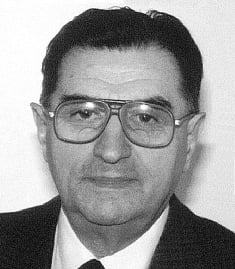Sándor Csibi
As a university student, he was a researcher at the Institute of Physics of the Budapest University of Technology (BME), the Laboratory of the Telecommunication Research Committee of the Department of Wireless Telecommunication (1949–1950), and the Laboratory of the Standard National Company and the BHG dealing with microwave telecommunications systems (1950–1951) (investigation of microwave passive and active circuits, modulation of the latter).
From 1951 to 1973, he was a research associate at the Telecommunications Research Institute (TKI), then a scientific department head, and finally the head of the Systems Theory and Computer Science Research Department; at that time, he directed the Institute's computer science research work. Between 1955 and 1969, in the field of increasing the transmission capacity of microwave connections, he discovered new relationships in the spectral theory of stationary processes, developed a new method for the empirical investigation of error phenomena in digital channels; developed stochastic methods for analyzing the interactions and internal nonlinearities of broadband angle modulation radio channels (with his results, he contributed to the reduction of the most critical quality indicator of the largest capacity, domestically produced backbone network system, the standard noise per telephone). From the 1970s, he investigated the possibilities of expanding the scope of application of small computers, and in this context, he researched solutions to statistical and information processing problems: with his independent research group at TKI, he launched theoretical research on statistical pattern recognition and classification theory, and initiated their practical application to biomedical signals. By the end of 1972, he introduced a new sample system for the introduction of diagnostic mass services of domestic small computers.
He was an external scientific associate at the Mathematical Research Institute of the Hungarian Academy of Sciences from 1968.
From 1973 to 1997 he taught and researched as a university professor at BME: until 1991 at the Telecommunications Electronics Institute (HEI), which he also founded and merged from the Departments of Wired and Wireless Telecommunications; between 1991-1997 at the Department of Telecommunications (established from half of the Institute). From 1975 to 1991 he was the director of HEI. He was an elected member of the BME University Council.
Together with ten of his fellow teachers, he developed and taught the subject Information Communication and Processing. The goal: to create common foundations in the field of stochastic methods for the teaching of further specialized subjects and for students' laboratory work. In addition, he taught the subjects Information Theory, Multiple Access Mass Serving and Coding Methods, and the introductory subject Information Technology. His research results are very significant.
He became a professor emeritus at BME in 1997. At that time, he conducted industrial-university research on information theory topics at the Department of Communications of the Faculty of Electrical Engineering and Informatics (VIK) of BME, together with domestic and foreign researchers.
In 1965 he was a Postdoctoral Fellow of the United Nations and the International Telecommunication Union. He attended and held research seminars in the information theory groups of Harvard University (USA), the University of California at Berkley (USA) and Stanford University (USA). Between 1971-1972 he was a visiting professor at the summer school of the International Center for Mechanical Sciences (CISM) in Udine (Italy). Between 1991-1992 he was a visiting professor at the Technical University of Darmstadt (Germany), and in 1999 he was a visiting research professor at the University of Texas (Dallas, USA).
Between 1972 and 1992 he was a member of the editorial board of the international journal Problems of Control and Information Theory.
In 1961 he received the degree of Candidate of Technical Sciences; in 1973 he obtained the degree of Doctor of Mathematical Sciences in probability and mathematical statistics. Since 1979 he has been a corresponding member of the Hungarian Academy of Sciences; since 1987 he has been a full member of the Hungarian Academy of Sciences. In 1994 he was elected an IEEE Fellow of the American Institute of Electrical and Electronic Engineers (IEEE). He was a member of the International Radio Science Union (URSI) and the New York Academy of Sciences (since 1988).
His awards: Order of Labor Merit, gold grade (Hungarian state, 1965); MTESZ Award (Association of Technical and Natural Science Associations); State Award (shared) (Hungarian state, 1970); Tivadar Puskás Memorial Medal (Minister of National Development, 1974); László Kalmár Award (János Neumann Computer Science Society (NJSZT), 1975).
- Az ún. „Cápa-klub” tagja volt. Együtt végeztek az egyetemen, és másodéves koruktól együtt készültek a vizsgákra; azután is jó barátok maradtak – még a síron túl is: Bach Iván (1927-2006), Boros Jolán Déri Jánosné (1921-2009), Csibi Sándor (1927-2003), Freud Géza (1922-1979), Frigyes Andor (1922-1992), Karsai Károly (1926-2004), Tevan György (1927-2009?) és Tuschák Róbert (1927-2018).
Created: 2016.06.28. 22:14
Utolsó módosítás: 2025.06.20. 12:01

